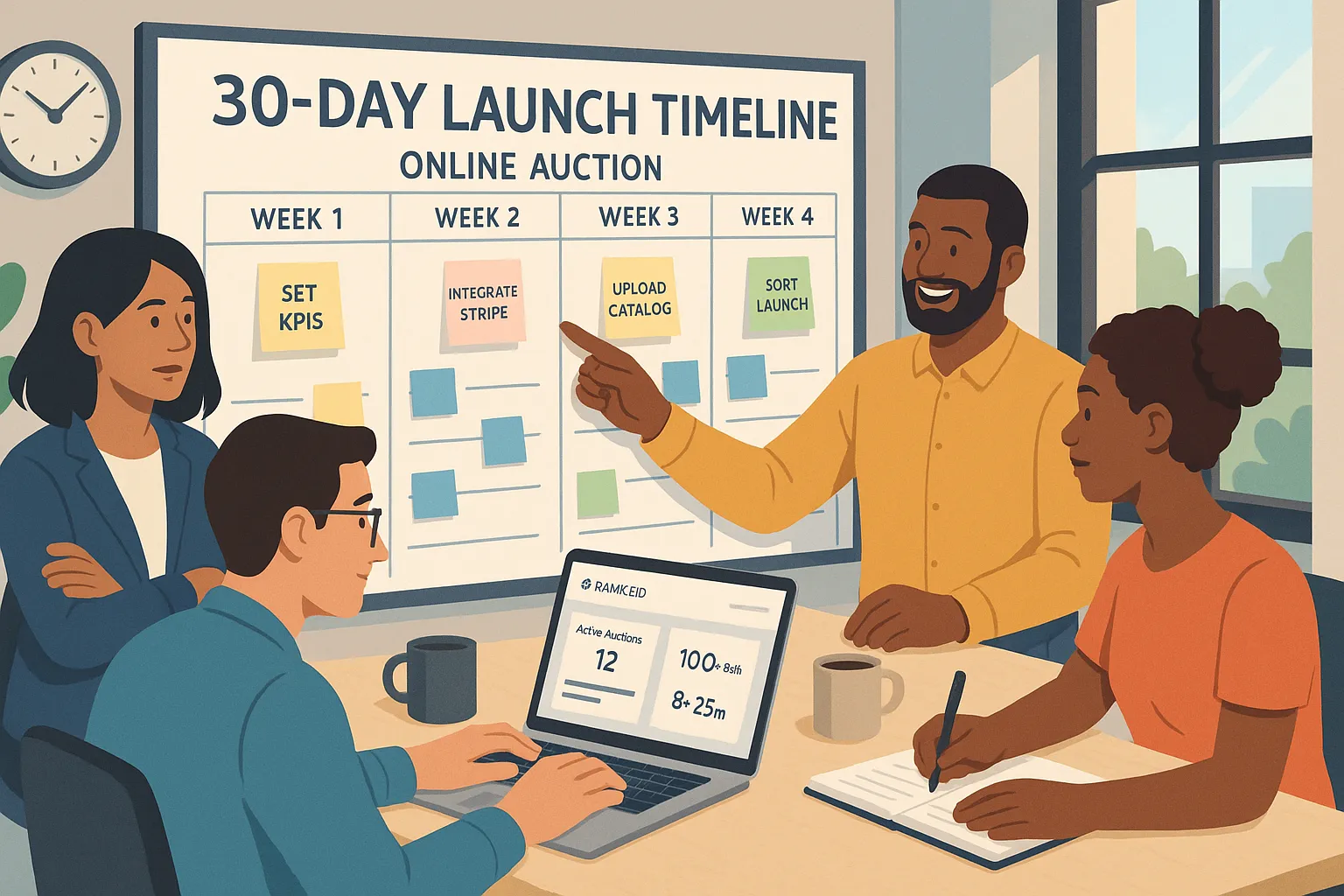The First 30 Days Checklist for Launching Your Online Auction Software

Ready, Set, Bid: Your First-Month Launch Plan
Launching an online auction platform can feel like orchestrating a live concert—you only get one opening night. The next 30 days will determine whether your auctions fizzle or become a reliable revenue engine. Use the checklist below as your week-by-week playbook to set up, integrate, test, and promote your new marketplace with confidence.
Tip: Bookmark this page and check tasks off as you go. When paired with Rankbid’s self-service interface and API, the timeline is realistic even for lean teams.
Days 1–7 | Set the Strategy & Foundation
Clarify goals and KPIs
Revenue target for the first three auctions
Desired bidder conversion rate
Acceptable payment-success rate (≥ 97 % is a healthy benchmark)
Choose your auction modelReview the pros and cons of First Price vs. Second Price vs. Transparent bidding in our guide “Understanding Auction Types”. Match the model to your inventory and audience sophistication.
Map your inventory pipeline
Number of lots or SKUs you can reliably list each week
Photo and description standards
Reserve-price policy
Select your tech stackIf you haven’t already, compare build-from-scratch costs with SaaS options. Rankbid covers hosting, uptime (99.999 %), and security so you can focus on sales, not servers.
Assign rolesYou’ll need at minimum:
Auction manager (catalog & scheduling)
Developer or no-code builder (integration, styling)
Finance lead (reconciliation, refunds)
Customer support owner
Days 8–14 | Integrate & Configure
Create your Rankbid workspace
Pick a plan (Free, Business, or Enterprise).
Enable two-factor authentication for admins.
Connect payments with StripeFollow the steps in “What is Stripe?” to activate live keys.
Set your payout schedule (daily or weekly)
Test a $1 sandbox transaction
Confirm webhook endpoints for payment-succeeded events
Add your branding
Upload logos and set primary colors
Configure domain or sub-domain (CNAME pointing to Rankbid)
Add SEO-friendly meta titles for each auction page
API & webhooks (optional)
Generate an API key
Create endpoints for listing creation, bid retrieval, and real-time status
Subscribe to “auction.ended” to trigger fulfillment workflows
Legal & compliance check
Draft auction terms (include payment-authorization language; see “When will I be charged for a bid?”)
Add privacy policy and GDPR opt-ins
Confirm sales-tax collection rules in target regions
Days 15–21 | Populate & Stress-Test
Upload your first catalog
High-resolution images (≥ 1200 px)
Descriptions with condition grades and shipping info
Start + end dates and time-zone consistency
Define pricing logic
Minimum bid increments
Automatic extension rules (e.g., extend by 2 min if a bid lands in the final 30 s)
Reserve vs. no-reserve split
Internal mock auction
Invite staff to place test bids
Simulate out-of-funds and expired-card scenarios
Confirm that losing bidders’ Stripe authorizations release within 24 h
Cross-device QA
Desktop (Chrome, Safari, Edge)
Mobile web + in-app WebView
Accessibility check: keyboard navigation and screen-reader labels
Performance audit
Latency < 200 ms for bid submissions (check with Rankbid’s status page)
Image CDN load times
Database read/write capacity (if you’re running API-heavy dashboards)
Days 22–26 | Market the Launch
Build your bidder list
Import past customers or newsletter subscribers
Segment by interest category
Create onboarding drip emails explaining how bidding works
Publish a teaser landing page
Countdown timer to first auction
Share sneak-peek photos of hero items
Include “Add to Calendar” links
Open pre-registration
Require credit-card verification early to reduce day-of churn
Offer a $10 bid credit for early sign-ups (credit is applied only if they win, to avoid fraud)
Activate social & paid ads
Short-form video demos on LinkedIn and Instagram
Retargeting pixels for visitors who view a lot page but don’t register
Budget: 20 % of projected first-auction revenue is a reasonable pilot
Prepare support resources
Update your help-center article “I have an issue, who should I contact?” with launch-specific links
Set up live-chat hours for auction night
Create a refunds and disputes flowchart for agents
Days 27–30 | Soft Launch → Full Launch
Soft-launch auction (internal + VIPs)
List 5–10 low-risk items
Monitor bids in real time (Rankbid dashboard › Live Auctions)
Record any failed payment events for root-cause analysis
Gather feedback
One-click post-auction survey to all participants
Note UI friction points and unexpected bidder behavior
Update FAQs accordingly
Optimize on the fly
Adjust bid increments if gaps are too large
Tweak countdown extension length to maintain excitement but avoid fatigue
Green-light public launch
Open your flagship auction with full inventory
Execute email and social blasts
Keep Slack/Teams war-room open for rapid issues triage
Review and report
Compare actuals vs. KPIs set on Day 1
Calculate net revenue after Rankbid fees and Stripe processing
Document learnings for next month’s roadmap (e.g., adding alternative payments under the Enterprise plan)
Pro Tips for Staying on Schedule
Automate notifications: Rankbid webhooks plus a Zapier/Slack integration keep your team in sync when high-value bids hit.
Leverage time-zones: Schedule closing times when your core audience is historically most active (e.g., 8 p.m. local time). Use analytics to refine.
Start with fewer SKUs: Quality photos and headlines drive higher bids than a sprawling but poorly described catalog.
Plan a post-auction upsell: Second-chance offers to under-bidders can boost revenue by 5–10 % with minimal effort.
30-Day Launch Recap
Strategy & team alignment
Payment and platform integration
Catalog creation and stress testing
Marketing buildup and bidder onboarding
Soft launch, iterate, open the floodgates
Follow this checklist and you’ll move from zero to a revenue-ready auction marketplace in just one month—without sacrificing sleep or customer trust. And remember, Rankbid’s support team is only an email away should you hit a snag.
Happy bidding, and see you in the live dashboards!